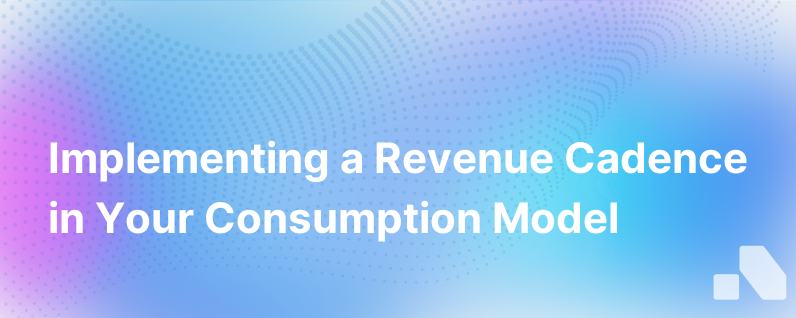Operationalizing Your Consumption Model With A Revenue Cadence
Published on December 4, 2023 by Sawyer Middeleer
In the dynamic realm of enterprise sales and business-to-business (B2B) transactions, maintaining a predictable revenue stream is the lifeblood of any thriving company. Today, the surge in subscription-based and usage-driven pricing models has shifted the traditional revenue landscape, prompting businesses to rethink how they monitor, predict, and grow their income.
A consumption-based model, wherein customers pay for services according to the amount they use, offers flexibility and scalability to clients while also presenting businesses with the challenge of predicting and operationalizing revenue streams. This is where developing a well-structured revenue cadence becomes crucial for success.
The Consumption Model Paradigm
The consumption model, popularized by cloud service providers and software-as-a-service (SaaS) companies, empowers customers to only pay for what they use, whether it be API calls, compute power, or other metered services. This model aligns costs directly with a customer's growth and operational pace, providing transparency and elasticity that traditional licensing models rarely afford.
For businesses, the consumption model promises recurring revenue and deeper customer engagement. However, this model also carries inherent unpredictability, as customer usage can fluctuate dramatically based on seasonal trends, business cycles, or external market forces.
Understanding Revenue Cadence
To navigate this uncertainty, businesses must implement a revenue cadence—a structured approach to tracking and managing revenue on a periodic basis. A solid revenue cadence gives businesses a clearer picture of when money will come in, informing better strategic and operational decisions. It includes forecasting, collection, recognition, and reporting.
The revenue cadence is essentially a rhythm that the finance, sales, and executive teams follow to evaluate performance against targets and strategize for growth. This recurring cycle can be monthly, quarterly, or annually, contingent upon the business model, sales cycle length, and customer usage patterns.
Consider a revenue cadence as a financial heartbeat of an organization. It's the regular check-up that lets the company know how healthy its revenue streams are, and what might need to be adjusted for optimal financial well-being.
Operationalizing Revenue in the Consumption Model
Operationalizing your consumption model with a revenue cadence involves several key steps. Here are elements to consider for creating an effective revenue cadence:
Establish Clear Metrics
Implement key performance indicators (KPIs) that align with the consumption model, such as Monthly Recurring Revenue (MRR), Average Revenue Per User (ARPU), Customer Lifetime Value (CLV), and Churn Rate. Each of these metrics tells a different facet's story concerning revenue health, allowing the business to dial in on specific areas needing attention.
Forecasting with Finesse
In a consumption model, usage is paramount. Therefore, forecasts must be closely linked to the predicted usage of services. This requires a keen understanding of your customers' business patterns and scaling needs, supported by robust data analytics. Realistic forecasting can cushion the volatility of a consumption-based revenue stream and ensure that resource allocation aligns with projected income.
Real-Time Monitoring
To stay agile in a consumption-based environment, companies need to monitor usage data almost in real-time. This enables them to identify trends quickly, adjust forecasts, and engage customers to optimize or expand their consumption. Platforms like Aomni are designed to track real-time account research and actionable competitive insights swiftly.
Customer Success Synergy
A consumption model thrives on customer satisfaction and growth. A dedicated customer success team that works in tandem with the revenue cycle can ensure customers are extracting maximum value from your service—which, in turn, stabilizes revenue. This team should be proactive, knowledgeable, and fully integrated into the revenue cadence.
Regular Adjustments and Reviews
An effective revenue cadence is not static. It will necessitate frequent adjustments based on new data, changing market conditions, and evolving customer patterns. Regular review sessions should be instituted, enabling teams to analyze deviations from forecasts, understand the reasons behind these changes, and refine strategies accordingly.
Robust Infrastructure
Technology platforms that ensure accurate billing, reporting, and data analysis are foundational to operationalizing the consumption model. They should provide granular visibility into consumption patterns and automate as much of the revenue cadence as possible to reduce administrative overhead and minimize errors.
Aligning Sales and Pricing
Sales teams must be acutely aware of how the consumption model impacts revenue and how their engagements affect customer usage patterns. Pricing strategies should encourage consumption while still aligning with value delivery. Training and incentives should be structured to support this alignment.
Transparent Communication
Externally, customers should have a clear understanding of their consumption, any caps or thresholds, and how their usage translates into costs. Internally, transparent communication about the revenue cadence allows for cross-departmental alignment, creating a cohesive team that works towards the same financial goals.
The path to a well-oiled revenue cadence within the consumption model is intricate but immensely rewarding when done right. It not only brings predictability to revenue streams but also solidifies customer relationships by continuously marrying service delivery with customer growth.
In conclusion, by diligently crafting a revenue cadence that takes into account the nuances of a consumption-based model, companies can operationalize their revenue streams, ensure stability, and pave the way for sustainable expansion and success. Platforms like Aomni can serve as a cornerstone in achieving these objectives by providing real-time insights and automation, making the transition to a consumption model a smooth and rewarding journey.